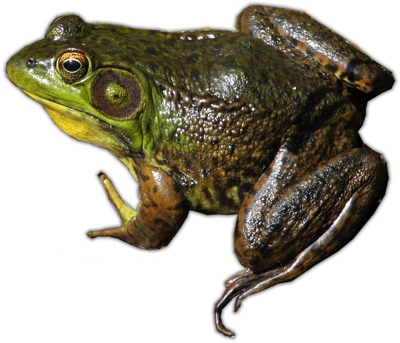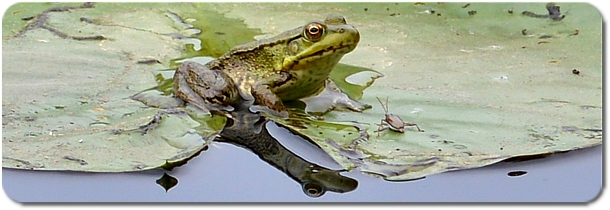Green Frog

What it looks like
The Green Frog is a large frog. Adults can have a body as long as 10 cm. Females are usually bigger than males. Males have an ear drum, called a tympanum, that is larger than their eye.
They are green to greenish brown on top with a few small black spots. There are dark or black stripes on the legs. Around the mouth the colour is usually bright green. The belly is white. (Photo by Simon Barrette)
Look-alikes
The Mink Frog and the Northern Leopard Frog can look like a Green Frog. A Mink Frog has no stripes on its legs and has many dark blotches. Northern Leopard Frogs have large black spots all over.
Common Name
The Green Frog is usually green in colour, but so are some other frogs. It is a common frog in eastern North America, so maybe it was just the first one to be called the Green Frog. In some areas where it lives they can be brown coloured and are called the Bronze Frog.
Scientific Name
The Green Frog's scientific name is Lithobates clamitans. Learn what that means on this page: Scientific Names.
Where it lives
The Green Frog lives near large water bodies such as lakes, large ponds or small rivers. This frog lives in eastern, central North America. It is only found in the southeast corner of Manitoba around Nopiming Provincial Park.
Where Green Frogs live in North America.
Habits
Green Frogs spends most of the time in or near the water waiting for insects or small animals to come close enough to catch. They hide near water plants or along the water edge by day. Adults don't go far from water, but young ones may move into wet grassy areas or forests. Green Frogs spend winter on the bottom of ponds, streams or lakes.

Green Frogs really do sit on water lily pads.
(Photo by Ryan Hodnett)
Food web
Green Frogs eat many kinds of insects and other small animals without backbones like snails and spiders.
Green Frogs are eaten by reptiles like the Common Snapping Turtle and garter snakes, and by wading birds like herons and egrets. Raccoons and minks are mammals that eat Green Frogs, too.
Life cycle
Green Frogs mate from June to mid-August. They breed along the edges of the water body they live in. Male Green Frogs stay in their own small area, their territory. They do not gather together to call for mates.
| Hear the Green Frog mating call: |
Females lay as many as 4000 eggs in one large bunch attached to plants at the surface of the water. The tadpoles hatch out in about 7 days, but will not change into froglets until the next summer. It takes more than a year, nearly 400 days, for a Green Frog egg to become a froglet. The new froglets are large. They can be as big as 5 cm long.
Numbers
There can be more than 50 Green Frogs in one hectare along the edge of a pond or lake. In Manitoba these frogs are rare because they are only found in a very small area of the province.
Special things
The Green Frog is rare in Manitoba and has a mating call that sounds like a broken guitar string: "clung!"
How to find Green Frogs
Listen for males calling from late June to early August along the edges of lakes or streams. The best time to hear them is evening or early in the morning, but they may call all day. In Manitoba, Nopiming Provincial Park is the best place to look or listen for a Green Frog.
Use by people
Green Frogs are rare in Manitoba and probably aren't used by people.
Special Note
There are very few pictures or videos of Green Frogs from Manitoba. If you catch or see one and take a photo or video, please send it along to NatureNorth.com at this address: Email NatureNorth.com.
| Next frog: Northern Leopard Frog | Back to: Amphibians and Reptiles Front Page |
